Introduction: Mary Harrell-Sesniak is a genealogist, author and editor with a strong technology background. In this blog post, Mary tells the history of St. Valentine’s Day, and describes some of the ways our ancestors celebrated this romantic holiday.
Valentines take many forms – from cards to flowers to romantic gestures – so why not take a look at Valentine’s Day traditions from history to generate new ideas of your own?
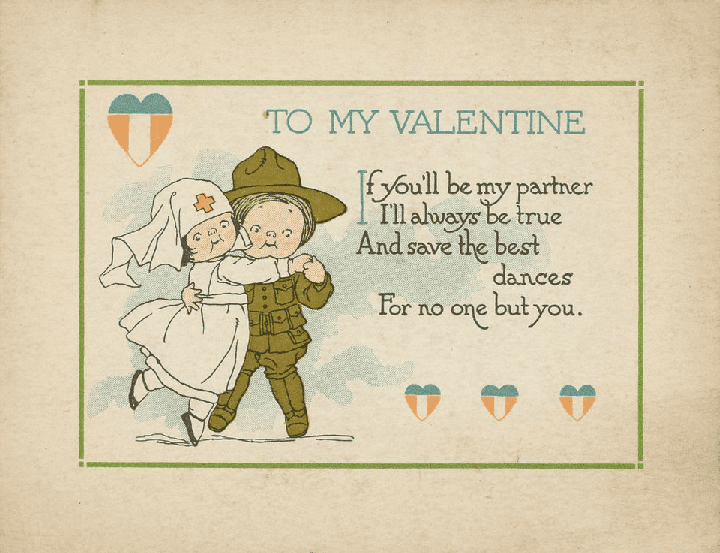
Saint Valentine
Our ancestors had many unique ways to celebrate Valentine’s Day, many of which centered on Saint Valentine or Valentinius of Italy.
Surprisingly little is known about Valentine, and the historical accounts of his life and death all differ. Most reports agree that he was a third century martyr who was beheaded on February 14 by the Romans for offering aid to Christians. But accounts differ as to what year he was executed, and by the order of which Roman emperor.
The story below, published in a 1913 newspaper, reports that Valentine rose through the offices of the church, but after becoming a bishop he was imprisoned by Calpernius, the High Sheriff. Roman Emperor Claudius wanted Valentine punished as a heathen, but passed the job onto Deputy Sheriff Asterius, whose daughter was blind. When Valentine saw her, he performed an exorcism which supposedly drove away the evil spirits causing her blindness. Her eyesight was restored and many, including Asterius, converted to Christianity. Unfortunately, Valentine was put back into prison and later beheaded.
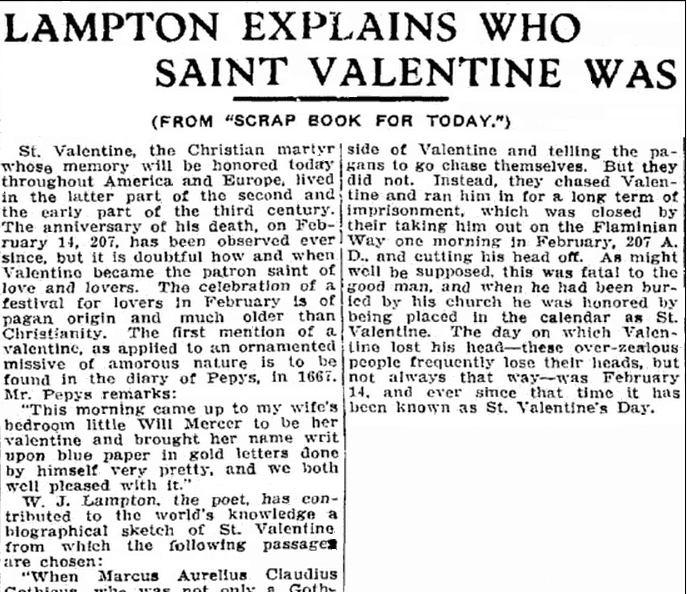
As the old newspaper article reports, the day Valentine lost his head (February 14) is also the day that lovers lose theirs:
The day on which Valentine lost his head – these over-zealous people frequently lose their heads, but not always that way – was February 14, and ever since that time it has been known as St. Valentine’s Day.
Romantic Poetry
Delightful Valentine’s Day poems abound in newspapers, including this excerpt about Cupid from Aesop’s “A Fable: The Wolf, the Sheep, and the Lamb” published in a 1749 newspaper.
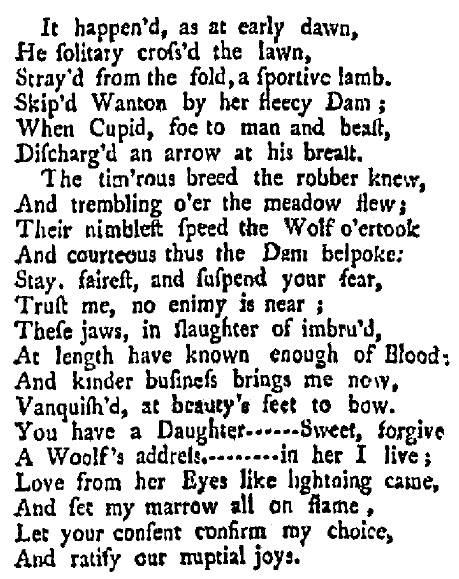
James Henry Hurdis (1800-1857), an artist and professor of poetry, alluded to the tradition of love knots in this poem from 1818. Love knots take many forms, but were often valentines written on paper or ribbon and tied in elaborate knots (see examples at this Victorian Rituals website).
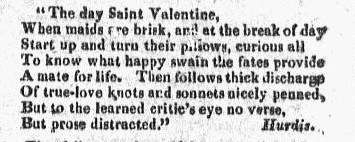
Sending Valentine Cards
One of the most popular forms of celebrating Valentine’s Day, of course, is the sending of valentine cards to express your love. Valentines, in the form of love poems, have been written since the Middle Ages. In the 18th century printed valentine cards, with poetry and sometimes decorations, were produced. Valentine cards became hugely popular in the 19th century when lower postage rates made it affordable to send cards in the mail. Today, billions of dollars are spent around the world on Valentine’s Day cards, flowers, chocolates, jewelry and other gifts.
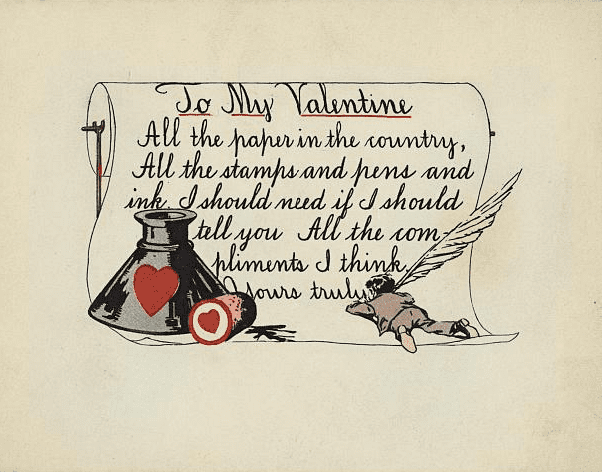
Anonymous Valentines
Sending unsigned anonymous valentines was an annual tradition in our household, and I wonder if my descendants will be puzzled at one of my unusual heirlooms: a large collection of unsigned Valentine’s Day cards. Every February, unsigned V-day cards and chocolate candies would arrive in the mail. We always knew they were from the grandparents, but that didn’t stop us from delighting in the festivities.
I used to think the tradition of anonymous valentines was unique to my family, but after finding comics (such as the 1894 cartoon below) and other references, I now realize that this Valentine’s Day tradition predates my grandparents.

Courtship Rituals
According to this 1856 newspaper article, gifts between would-be lovers are a long-honored Valentine’s Day practice, and one that the romantic Madame Royale helped establish. As the daughter of Henry the Fourth of France, she frequently hosted balls at her palace near Turin, which was appropriately called Valentine.
[search_box]
Knights were instructed to present nosegays to their ladies, and in exchange, the belles furnished trappings or decorations for their admirers’ horses. If the knight won the tournament, he then presented the prize to his beloved.
As the historical news article reports:
At the various balls which this gallant princess gave during the year, it was directed that each lady should receive a nosegay from her lover, and that at every tournament the knight’s trappings for his horse should be furnished by his allotted mistress, with this proviso, that the prize obtained should be hers. These pleasant interchanges among the ‘young people’ finally grew into a custom, and thus originated the exchange of love tokens on St. Valentine’s Day.
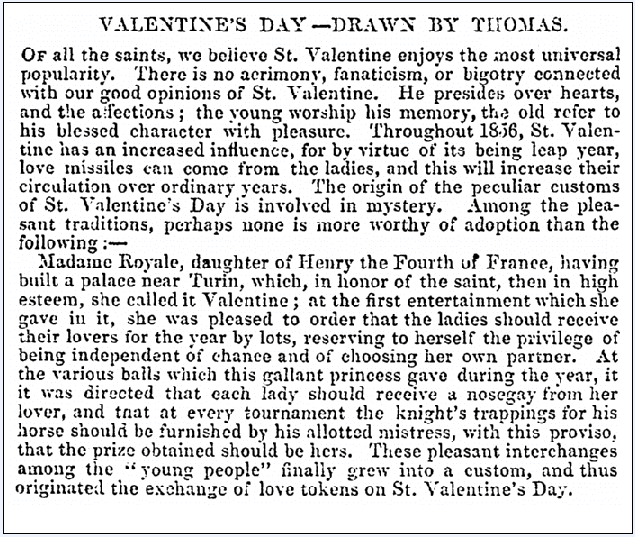
Bay Leaves, Clay Balls and Hardboiled Eggs
According to this 1874 newspaper article about grandmotherly traditions, our female ancestors celebrated Valentine’s Day by pinning bay leaves to their pillows.
The ritual including dreaming of one’s sweetheart in hopes of being married within the year. Another Valentine’s Day tradition entailed writing lovers’ names on bits of paper, rolling them in clay and then placing them under water. Whichever name rose to the surface first would be the Valentine.
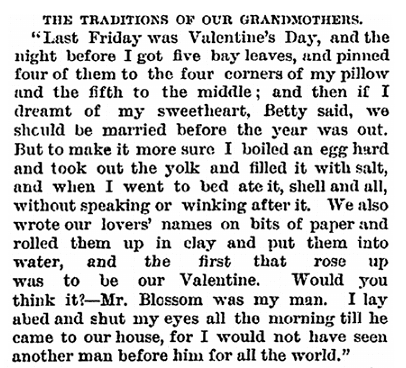
There was another ritual in this Valentine’s Day tradition which has thankfully died out! The yolk of a hardboiled egg was replaced with salt, and then the egg was eaten – shell and all – without speaking of one’s sweetheart or even “winking” after him.
Hope you have a very happy Valentine’s Day. Please share any favorite holiday traditions with us in the comments section.
Related Valentine’s Day Articles:
- Old Fashioned Valentine’s Day Treats & Sweets
- Valentine’s Day History: A Look Back at Old Love Poems & More
- 3 True-Life Love Stories to Brighten Your Valentine’s Day
[bottom_post_ad]

I want some chocolate candy.